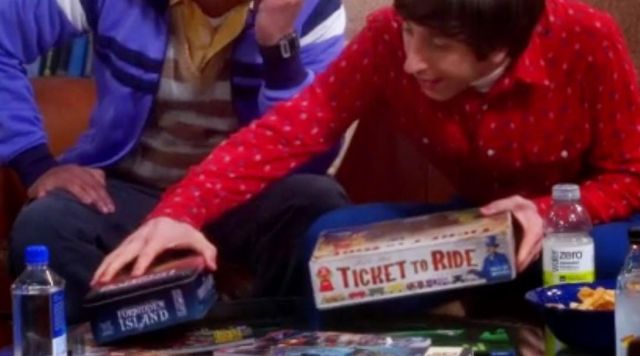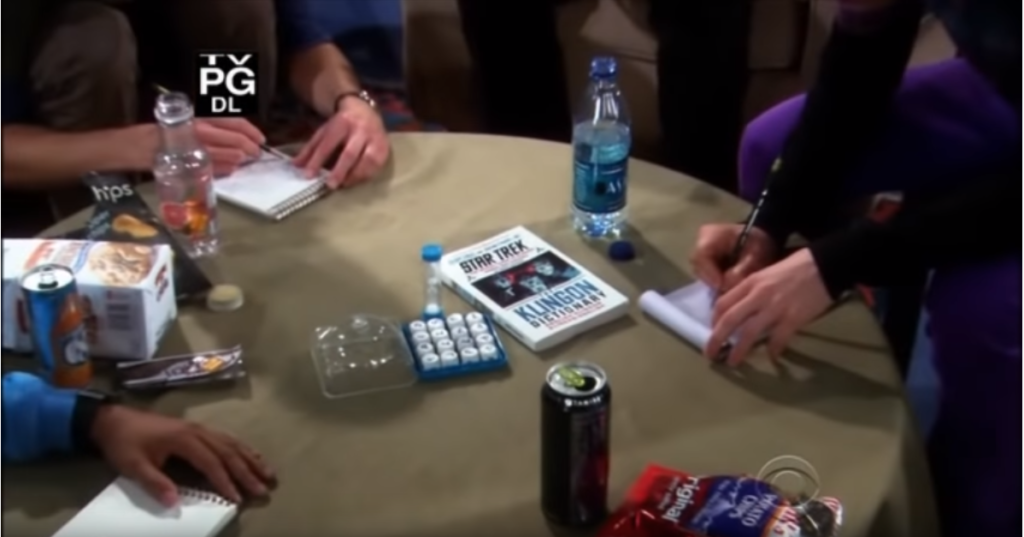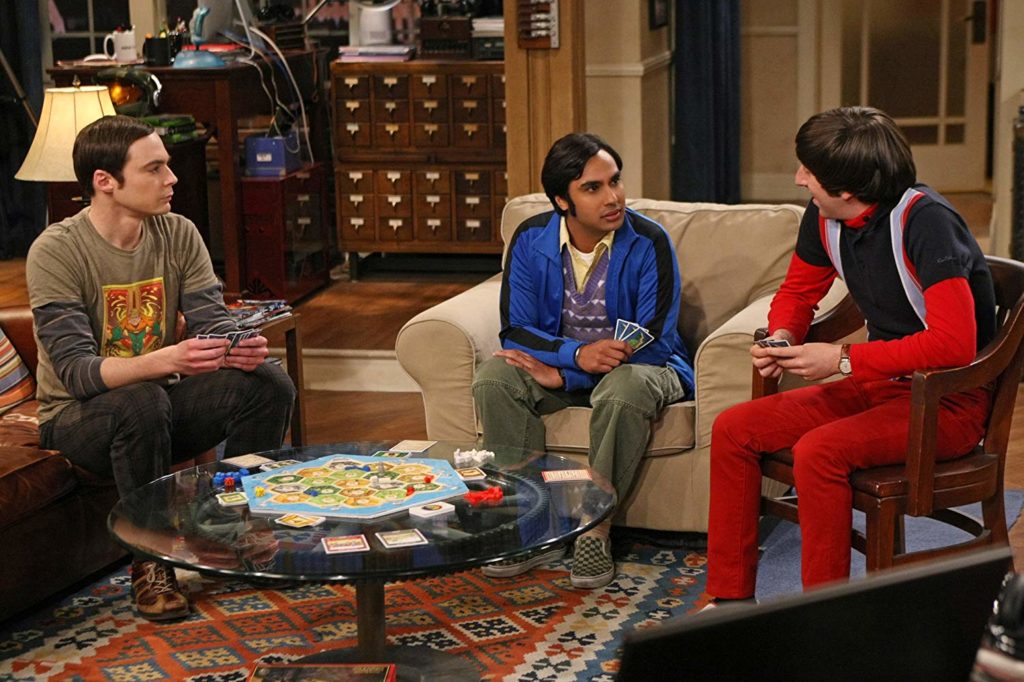The Big Bang Theory is known for its subtle inclusions of pop culture references throughout the series one of the most notable inclusions are the tabletop board games scattered throughout is episodes.
Here are some of the main games included in the series that you may have missed with a little bit more detail about them and where you can get a copy if you want to play them yourself.
Ticket to Ride

Episode
Season 8 Episode 13 – The The Anxiety Optimization
Ticket to Ride Description
With elegantly simple gameplay, Ticket to Ride can be learned in under 15 minutes. Players collect cards of various types of train cars they then use to claim railway routes in North America. The longer the routes, the more points they earn. Additional points come to those who fulfil Destination Tickets – goal cards that connect distant cities; and to the player who builds the longest continuous route.
“The rules are simple enough to write on a train ticket – each turn you either draw more cards, claim a route, or get additional Destination Tickets,” says Ticket to Ride author, Alan R. Moon. “The tension comes from being forced to balance greed – adding more cards to your hand, and fear – losing a critical route to a competitor.”
Ticket to Ride continues in the tradition of Days of Wonder‘s big format board games featuring high-quality illustrations and components including an oversize board map of North America, 225 custom-moulded train cars, 144 illustrated cards, and wooden scoring markers.
Since its introduction and numerous subsequent awards, Ticket to Ride has become the BoardGameGeek epitome of a “gateway game” — simple enough to be taught in a few minutes, and with enough action and tension to keep new players involved and in the game for the duration.
Click the Link to Check it out on Amazon
Monopoly (India Edition)

Episode
Season 4 Episode 09 – The Boyfriend Complexity
Monopoly Description
During this episode, we learn that Sheldon only prefers the classic styles of Monopoly: regular and Klingon and The group were playing Monopoly India Edition.
The official description of the game states that in this Fast Dealing Property Game! Players will witness their children live out their ultimate fantasy of buying and selling entire cities in this fascinating and popular Funskool Monopoly India Edition board game.
The idea of the game is to transform you into an astute and prudent dealer, scoring points by buying and selling cities like Mumbai, Delhi and Kolkata. Gameplay involves rolling the dice and moving forward through various cities. Also included are chance cards, deeds, houses and hotels to keep you engrossed in this interesting game. The Monopoly Board Game also allows you to buy ports, railways, and other real estates to further grow and enhance your business
Click the Link to Check it out on Amazon
Forbidden Island

Episode
Season 8 Episode 13 – The The Anxiety Optimization
Forbidden Island Description
Forbidden Island is a visually stunning cooperative board game. Instead of winning by competing with other players like most games, everyone must work together to win the game. Players take turns moving their pawns around the ‘island’, which is built by arranging the many beautifully screen-printed tiles before play begins. As the game progresses, more and more island tiles sink, becoming unavailable, and the pace increases. Players use strategies to keep the island from sinking while trying to collect treasures and items. As the water level rises, it gets more difficult- sacrifices must be made.
What causes this game to truly stand out among co-op and competitive games alike is the extreme detail that has been paid to the physical components of the game. It comes in a sturdy and organized tin of good shelf storage size. The plastic treasure pieces and wooden pawns are well crafted and they fit just right into the box. The cards are durable, well printed, and easy to understand. The island tiles are the real gem: they are screen-printed with vibrant colours, each with a unique and pleasing image.
With multiple levels of difficulty, different characters to choose from (each with a special ability of their own), many optional island formats and game variations available, Forbidden Island has huge replay value. The game can be played by as few as two players and up to four (though it can accommodate five). More players translate into a faster and more difficult game, though the extra help can make all the difference. This is a fun game, tricky for players of almost any age. Selling for under twenty dollars, oddly, Forbidden Island is a rare game of both quality and affordable price.
Click the Link to Check it out on Amazon
Klingon Boggle

Episode
Season 2 Episode 07 – The Panty Piñata Polarization
Klingon Boggle Description
This is a combination of two different items the Game Big Boggle and a Klingon Dictionary.
Big Boggle is a timed word game where players attempt to find as many connected words as possible from the face up letters resting in a 25 cube grid. When the timer runs out, players compare their list of words and remove any shared words. Points are then awarded for remaining words, depending on how many letters are in the word.
Big Boggle is similar to the standard Boggle, but with the following changes:
- uses a 5×5 grid instead of 4×4
- the minimum word size is 4 letters instead of 3
Click the Link to Check it out on Amazon
Giant Jenga
Episode
Season 6, Episode 12 “The Egg Salad Equivalency
Giant Jenga Description
Giant Jenga is an Extra Large Version of the game Jenga a board game that is played with 54 wooden blocks; each block is 3 times as long as it is wide and slightly smaller in height than in width.
The blocks are stacked in a tower formation; each story is three blocks placed adjacent to each other along their long side, and each story is placed perpendicular to the previous (so, for example, if the blocks in the first story are pointing north-south, the second story blocks will point east-west). There are therefore 18 stories to the Jenga tower. Since stacking the blocks neatly can be tedious, a plastic loading tray is included.
Once the tower is built, the person who built the tower moves first. Moving in Jenga consists of taking one and only one block from any storey except the completed top story of the tower at the time of the turn, and placing it on the topmost story in order to complete it. Only one hand at a time may be used to remove a block; both hands can be used, but only one hand may be on the tower at a time. Blocks may be bumped to find a loose block that will not disturb the rest of the tower.
Any block that is moved out of place may be left out of place if it is determined that it will knock the tower over if it is removed. The turn ends when the next person to move touches the tower, although he or she can wait 10 seconds before moving for the previous turn to end if they believe the tower will fall in that time.
The game ends when the tower falls in any significant way — in other words, any piece falls from the tower, other than the piece being knocked out to move to the top. The loser is the person who made the tower fall (i.e. whose turn it was when the tower fell); the winner is the person who moved before the loser.
Click the Link to Check it out on Amazon
Catan

Episode
Season 5 Episode 11 – The Speckerman Recurrence
Catan Description
In Catan (formerly The Settlers of Catan), players try to be the dominant force on the island of Catan by building settlements, cities, and roads. On each turn dice are rolled to determine what resources the island produces. Players collect these resources (cards)—wood, grain, brick, sheep, or stone—to build up their civilizations to get to 10 victory points and win the game.
Setup includes randomly placing large hexagonal tiles (each showing a resource or the desert) in a honeycomb shape and surrounding them with water tiles, some of which contain ports of exchange. Number disks, which will correspond to die rolls (two 6-sided dice are used), are placed on each resource tile. Each player is given two settlements (think: houses) and roads (sticks) which are, in turn, placed on intersections and borders of the resource tiles. Players collect a hand of resource cards based on which hex tiles their last-placed house is adjacent to. A robber pawn is placed on the desert tile.
A turn consists of possibly playing a development card, rolling the dice, everyone (perhaps) collecting resource cards based on the roll and position of houses (or upgraded cities—think: hotels) unless a 7 is rolled, turning in resource cards (if possible and desired) for improvements, trading cards at a port, and trading resource cards with other players. If a 7 is rolled, the active player moves the robber to a new hex tile and steals resource cards from other players who have built structures adjacent to that tile.
Points are accumulated by building settlements and cities, having the longest road and the largest army (from some of the development cards), and gathering certain development cards that simply award victory points. When a player has gathered 10 points (some of which may be held in secret), he announces his total and claims the win.
Catan has won multiple awards and is one of the most popular games in recent history due to its amazing ability to appeal to experienced gamers as well as those new to the hobby.
Click the Link to Check it out on Amazon
Dungeons & Dragons

Episode
Season 5, Episode 4 – The Wiggly Finger Catalyst
Dungeons & Dragons Description
Dungeons & Dragons is a group storytelling game.
Do you remember the choose-your-own-adventure book’s from the ’90s? Think of D&D as a collective version of one of those? One of the players (the DM, we will get to that later) prepares an adventure (or downloads one off the internet).
Then the rest of the players take characters into that story and gather together—preferably around a table given the space requirements for this game—to cooperatively tell the tale (or decide to throw you into a well – Yes Jessie I still haven’t forgotten about that).
Whatever story the players and the dungeon master decide to tell there is not a single way to tell a story, there is also not a “right” way to play D&D, but it does need to be experienced or at least watched to be understood.
To Find our more Check Out our Beginners Guide to Dungeons and Dragons
Full List of Games Sighted During the series
Links Included to where you can find more about these games and get a copy.
- Jenga (regular and Giant)
- Star Trek 3D Chess
- Chess sets of various themes seen in the guy’s apartment, at Howard & Bernies, and at the Comic Book Shop
- Talisman
- Battleship (a space-themed version with pen and paper)
- Big Boggle (played Klingon-style)
- Dungeons & Dragons
- Pictionary
- Power Grid
- Space Alert, and Arctic Scavengers (at the comic book store, IIRC)
- Elder Sign
- Settlers of Catan
- Ticket To Ride
- Campaign for North Africa
- Dominion
- Tikal
- Race for the Galaxy
- Star Trek Monopoly
- Cinque Terra
- Castle Ravenloft (the board game, not the D&D module)
- Forbidden Island
- Monopoly (Indian edition, or maybe a specific Indian city edition, dunno which)
- Risk (the Lord of the Rings version, but I am not sure which LOTR version it was, or even if there is more than on LOTR Risk)
Conclusion
Did we miss any games? Let us know in the comments below.

